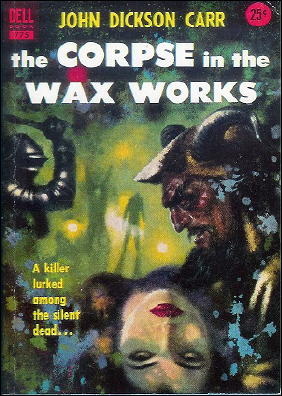Search Results for 'John Dickson Carr'
Did you find what you wanted ?
Tue 26 Nov 2013
A Review by MIKE TOONEY:
JOHN DICKSON CARR’S “THE THREE COFFINS”: A HOLLOW VICTORY? by J. Morris. CADS Supplement 13, 2011. 54 pages; illustrated with diagrams, maps, and photographs. Appendix I: Floor Plan of the Crime Scene. Appendix II: “The London of THE THREE COFFINS” by Tony Medawar.
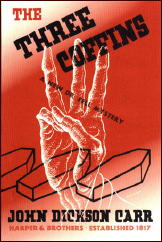
Previously on ONTOS, there was a posting about John Dickson Carr’s immensely popular THE THREE COFFINS (a.k.a. THE HOLLOW MAN) editorially wondering out loud whether it might be his best novel.
If you’re in the same crowd with Edward D. Hoch and Julian Symons who thought it was, after reading J. Morris’s CADS monograph, you might change your mind.
In his introduction, Morris tells us:
“There are elements of THE THREE COFFINS which I admire greatly, and these will be pointed out from time to time in what follows, and highlighted in the concluding section. However, my analysis is overall extremely critical of Carr’s book. Unlike, for instance, THE CROOKED HINGE or THE JUDAS WINDOW … THE THREE COFFINS, in my view as against [Douglas] Greene’s, can only disappoint, the more carefully it is reread. Its defects are wider and deeper than the two or three most commonly noted difficulties with the main plot construction.”
Essentially, by a close reading of the text, Morris has identified over two dozen mistakes which Carr and his supposedly punctilious editors somehow overlooked when the book went to press. Typically these errors are of a factual or logical nature, given what has been established in Carr’s narrative, thus threatening to unravel the author’s own carefully wrought construction:
“I will point out discrepancies, unexplained facts, impossibilities, implausibilities, misdirection that I consider unfair—and occasional moments of inspired mystification. In any analysis of this sort, meta-questions about fair-play conventions will necessarily arise, and I will point these out but not pursue them at great length.”
As Morris notes, Carr occasionally trips himself up due to a tendency—not always indulged in—towards what Morris terms Unnecessary Webwork, imposing thematic resonances that could easily have been dispensed with.
Among the twenty-five “problems” Morris discovers in THE THREE COFFINS, he pinpoints six of them as being major flaws:
– “The Problem of the Unnoticed Haze”
– “The Problem of the Dying Man’s Lie”
– “The Problem of the Bamboozled Detective”
– “The Problem of the Panicked Murderer”
– “The Famous Time Problem”
– “The Problem of Twenty Minutes”
To be fair to Carr, Morris also gives six good reasons why THE THREE COFFINS should not be scorned, even with all its defects.
And be forewarned: Morris tells us that A HOLLOW VICTORY? is “one huge spoiler, for obvious reasons. Those unfamiliar with THE THREE COFFINS should leave the premises.”
All in all, A HOLLOW VICTORY? is a fine addition to Golden Age of Detection scholarship.
Editorial Comment: This review first appeared on Mike’s own new blog:
http://carrdickson.blogspot.com/. Check it out.
Fri 8 Mar 2013
Posted by Steve under
Authors[4] Comments
HUMOR & JOHN DICKSON CARR
by Marv Lachman.
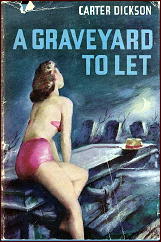
Rereading portions of the Sir Henry Merrivale series recently made me realize again how humor in the mystery has deteriorated since the days of Carr-Dickson, Craig Rice, and Alan Green. Nowadays the closest we come to humor is the first-person narrator emulating a stand-up comedian with wisecracks. Spenser, Claire Malloy, and Kinky Friedman are examples.
In the Merrivale series almost every book had a slapstick sequence that was the mystery equivalent of the Marx Brothers. Take the riot Sir Henry causes on the New York subways in A Graveyard to Let (1949).
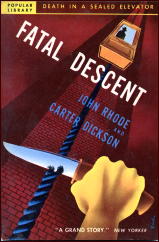
The humor in the series is not entirely visual — e.g., the delicious confusion between the words “kleptomania” and “nymphomania” in Fatal Descent. Sure, John Rhode is listed as co-author of that 1939 book, but does anyone really think Rhode could have written those lines, even if his life depended on it?
In the same book, the unimaginative Inspector Hornbeam says regarding a corpse discovered in a double-locked “room” (a sealed elevator car within a sealed elevator shaft): “There’s a flaw somewhere. There’s got to be. Otherwise the thing’s impossible. And it’s impossible for a thing to be impossible.”
Pure Carr.
— From
The MYSTERY FANcier, Vol. 13, No. 1, Winter 1991.
Mon 5 Dec 2011
Posted by Steve under
Reviews[6] Comments
IT’S ABOUT CRIME, by Marvin Lachman
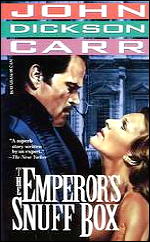
JOHN DICKSON CARR – The Emperor’s Snuff-Box (Carroll & Graf, paperback reprint, 1986. Harper & Brothers, hardcover, 1942. Many other editions, both hardcover & paperback. Film: That Woman Opposite (UK, 1957) aka City After Midnight (US).
This book is best described by quoting Carr, himself, regarding the murder in it: “This is a domestic crime. A cozy, comfortable, hearth-rug murder.”
Though not the author at his best, this is typical Carr. There is love at first sight, and the setting is France, though most of the characters are British. There is less atmosphere than usual, and the puzzle is a bit less complicated, and therefore more guessable than most Carr’s.
None of Carr’s usual series characters are present; the murder is investigated by a French policeman and a vacationing British psychiatrist. The time is the summer of 1939 and the delight of a simpler time and an intriguing puzzle make this worthwhile, even if it is not Carr at his peak.
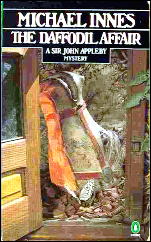
MICHAEL INNES – The Daffodil Affair. Penguin, paperback reprint, 1984. Several other paperback editions. Dodd Mead, hardcover, 1942.
— The Weight of the Evidence. Perennial Library, paperback reprint, 1983. Several other paperback editions. Dodd Mead, hardcover, 1943.
These books, original1y published in 1942 and 1943 respectively, come from the most imaginative period in the career of this writer who has been publishing mysteries for fifty years.
Daffodil is probably too wild and improbable for its own good, as we are asked to believe, on the basis of flimsy evidence, that Appleby and another Scotland Yard inspector would be sent out of war-time London into the jungles of South America.
The story begins attractively with the stolen titular horse and is heavy on human and animal psychology, accurately using the famous “Hans Legacy” about teaching horses tricks.
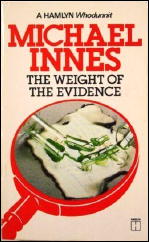
Finally, there is too little action and too unlikely an ending to justify what is otherwise an unusual and sophisticated book.
The Weight of the Evidence is relatively conventional for Innes, with its British university setting immediately before World War II, but it opens with an unpopular professor found crushed to death by a meteor.
It’s all very clever, but sometimes the literary allusions and sheer number of eccentric characters is a bit overdone. There’s a lot of good detection, though it is weakened by too much coincidence and a fortuitous confession at the end.
— Reprinted from The MYSTERY FANcier,
Vol. 8, No. 4, July-Aug 1986.
Tue 8 Nov 2011
Posted by Steve under
Reviews[6] Comments
Reviewed by RICHARD & KAREN LA PORTE:
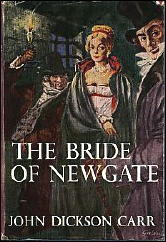
JOHN DICKSON CARR – The Bride of Newgate. Harper & Brothers, hardcover, 1950. Paperback reprints include: Avon 476, 1952; Avon T-391, 1960; Curtis, 1971; Carroll & Graf, 1986.
Dick Darwent is to be hanged in front of Newgate Prison at dawn tomorrow for a murder he did not commit. Caroline Ross must be married in order to collect a legacy, but she does not want a husband. An unholy alliance is made to make her an almost instant widow, and Reverend Horace Cotton, the Ordinary of Newgate, performs the ceremony in Darwent’s cell.
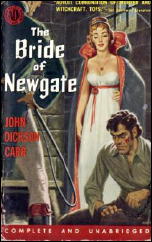
“The Bride of Newgate” returns to her friends and their pre-hanging party across the street from the gallows. But fate in the form of the Battle of Waterloo cuts down Dick’s uncle and two cousins in the prime of their lives and leaves Darwent the family title. Dick, now a Peer, can only be tried in the House of Lords, who forthwith pardon him.
The year is 1815. Now armed with a title, money and property, Darwent can track down the evil “Coachman” responsible for the murder that he was to be hanged for. Caroline, heiress and marchioness, falls one-sidedly in love with Dick. Married in name only, she aids and abets his search to unravel the twisted background of the crime.
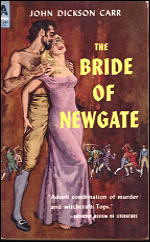
Through a set of interlocking puzzles, Dick finds out that he was kidnapped and framed by mistake. With duels, a disappearing room, brawls and arson, the action is fast and violent. The London of 1815 is wrapped around the story until you can almost smell it.
Reverend Cotton is only one of a cast of colorful characters winging in and out of this spectacle. Scenes range from the House of Lords and the gaming clubs of Mayfair to the meanest gin shops in the East End.
Time has not tarnished this tale. John Dickson Carr was as noted for his historical fiction as he was for his locked room stories with Dr. Gideon Fell and Sir Henry Merrivale. This fresh reprint [from Carroll & Graf] makes another fascinating story available in a handsomely bound paperback.
— Reprinted from The Poisoned Pen, Vol. 7, No. 1, Fall-Winter 1987.
Thu 27 Oct 2011
Posted by Steve under
Reviews[8] Comments
Reviewed by RICHARD & KAREN LA PORTE:
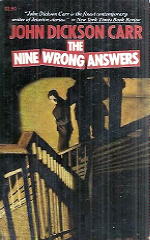
JOHN DICKSON CARR – The Nine Wrong Answers: A Novel For The Curious. Carroll & Graf, paperback reprint, 1986. Hardcover edition: Harper & Brothers, 1952. Also reprinted in paperback by Bantam: 1955 (shown), 1962.
In this tightly wound tale of impersonation, fortune hunting, heir baiting and generally obnoxious skulduggery, John Dickson Carr intersperses the text with nine answers to questions that might lie in the mind of the justly suspicious reader. Each step in this carefully choreographed cat-and-mouse ballet leads the reader into another intellectual pitfall.
Bill Dawson, down on his luck in New York, falls into a proposition that he can’t say no to. He will, for a fee of $10,000, return to England as Laurence Hurst, heir to a considerable fortune from his doddering uncle Gaylord Hurst. The only catch to this game is that Dawson must call weekly on Uncle Gay and be a proper nephew and heir.
The switch in identities is quickly made and Dawson is on his way to England. He isn’t even across the briny when his ex-flame Marjorie Blair insinuates herself into the adjoining seat and into his plans by unmasking him without a moment’s hesitation.
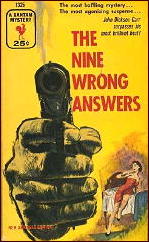
If she can spot his deception, how long will it take for Uncle Gay to penetrate the disguise and turn his sadistic manservant loose? When this comes true, the cat-and-mouse game starts. Bill “Larry Hurst” Dawson will inherit nothing, unless he outlives Uncle Gay and Uncle Gay swears that Dawson won’t live out the week. THE GAME IS AFOOT!
The Nine Wrong Answers is a Sherlock Holmes buff’s treasure. Not only is the great detective cited as an authority on many of the points raised in the pursuit of truth in this tale but one of the final scenes takes place in and around the Sherlock Holmes sitting room prepared for the 1951 Exhibition in Baker Street.
As ever, Carr’s characters are complex and well developed and the plot is sufficiently convoluted to test the wits of the most sophisticated reader. This book has been too long out of print. We welcome it back as a classic “MUST” on everyone’s list.
— Reprinted from The Poisoned Pen, Vol. 7, No. 1, Fall-Winter 1987.
Thu 16 Dec 2010
Posted by Steve under
Reviews[9] Comments
IT’S ABOUT CRIME
by Marvin Lachman
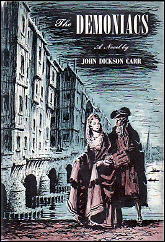
— Reprinted from
The MYSTERY FANcier,
Vol. 11, No. 4, Fall 1989.
… Carroll & Graf has also reprinted John Dickson Carr’s historical mystery, The Demoniacs (1962). This is not top-class Carr; the murder method is unconvincing, and there are too few suspects. Also, many characters are given the annoying habit of answering questions with questions.
Still, London in 1757 comes remarkably alive, and we learn a great deal about the famous mercenary thief-takers of the time, through the hero, Jeffrey Wynne, “the only honest Bow St. Runner.” Also interesting is Carr’s description of a massage parlor, written a few years before they became so popular in the sleazy areas of our cities.
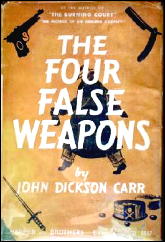
Proof of Carr’s popularity is that two other publishers are also reprinting his work. Harper’s Perennial Library has just issued four books, and only one is in any way weak.
The Four False Weapons (1937) is the last and weakest of Carr’s Henri Bencolin series, and it could have used a less muddled solution, as well as a diagram of the hard-to-picture murder house. The characters and their emotional responses are so implausible they prove distracting.
However, Carr is at or close to his best in the three Gideon Fell books from Perennial. The Mad Hatter Mystery (1933) is chronologically the second Fell book, and who can resist its bizarre plot, with top hats being stolen all over London?
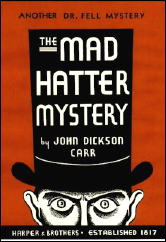
One hat turns up on the head of a corpse found in the Tower of London, a building whose physical aspects are important to the plot. The book is also about an unknown Poe manuscript which supposedly predates “Murders in the Rue Morgue.”
Carr even provides this poignant description of the unhappy Poe: “Never in his life would that dark man have anything, but dreams to exchange at last for the cold coin of an immortal name.”
Long ago in these pages (Vol. 2, No.3, May 1978), I wrote an article about Carr in which I described how he usually had a character who embodied much of his own history and traits and acted as Watson to Dr. Fell’s Holmes.
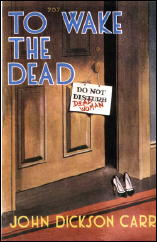
Christopher Kent in another Perennial reprint, To Wake the Dead (1938), is one of Carr’s most appealing of these secondary players, a mystery writer who finds a corpse in a London hotel who turns out to be his cousin’s wife. So strong are Carr’s narrative powers in this book that we accept coincidences we might not take from lesser suspense writers.
The Case of the Constant Suicides (1941) is one of the three best Fell books, high praise indeed. (The very best of the Fells, The Crooked Hinge [1938], was reprinted by Perennial in the summer of 1989 and is still available.)
Constant Suicide’s hero is, like Carr, an American in the British Isles. Alan Campbell’s train journey to Scotland, in which he meets an attractive, mysterious woman (also named Campbell), is a near perfect beginning. The setting, a castle in the Highlands, and the intricate murder puzzle also could hardly be improved upon.
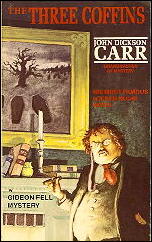
IPL has no fewer than twenty Carrs in print, including nine as Carter Dickson, and I am tempted to take the easy road and merely recommend all of them. Well, I do recommend them all, but I will select some favorites among them:
Seldom have atmosphere and puzzle been more happily married in a mystery than in Hag’s Nook (1933), the first and one of my three favorite Fells. The Three Coffins (1935) is arguably Carr’s most famous book, and because of its famous lecture chapter is probably the seminal work on locked rooms. Though Barzun and Taylor detested it, the exotic Below Suspicion (1949) is one of the best of the “later” Carrs.
It may be sacrilege, but in general I prefer the books Carr wrote as Dickson. The puzzles were as good, and Carr wrote some hilarious scenes of slapstick, usually for the entrance upon the scene of the “Old Man,” as his detective, Sir Henry Merrivale, calls himself.
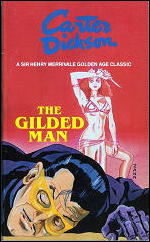
In He Wouldn’t Kill Patience (1944), my favorite of all Carr’s seventy-plus books, we meet him being chased around the reptile house by a large tropical lizard. This ingenious “locked zoo” mystery is enhanced by a cast of magicians — and the background of London blacked out in the “blitz.”
In The Reader Is Warned (1939) Merrivale solves a murder with impossible elements, though not in a locked room. We also have Merrivale driving a train and hitting a cow. Why is HM driving a train and how did the beast get on the tracks? That’s a bonus to the mystery, if you read the book.
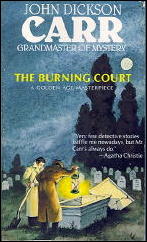
The Gilded Man (1942) is one of the most enjoyable weekend-house-party mysteries ever written. Besides a wild and wickedly clever puzzle, there is Merrivale, as a substitute magician and mixing axioms. “The cat’s been at the spilt milk. There’s none left to weep over.”
One more Carr from IPL must be mentioned, a non-series entry, the justly famous The Burning Court (1937). Ordinarily, when an author introduces elements of the supernatural into a mystery, I shout “Cop-out” and throw the book aside. Carr not only does it in this book, along with some non-science-fictional time travel, but he had me eating out of his literary hand and loving it.
Tue 14 Dec 2010
Posted by Steve under
Reviews[11] Comments
REVIEWED BY TINA KARELSON:
JOHN DICKSON CARR – He Who Whispers. Harper & Brothers, US, hardcover, 1946. UK edition: Hamish Hamilton, hc, 1946. Reprinted many times, in both hardcover and paperback, including International Polygonics, 1986. (Cover art: Roger Roth.)
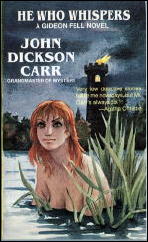
Gideon Fell is amusingly absent-minded in this eerily atmospheric novel set in London in the immediate aftermath of the Second World War:
“Waterloo, its curving acre of iron-girdered roof still darkened over except where a few patches of glass remained after the shake of bombs, had got over most of the Saturday rush to Bournemouth.”
This description of the iconic London railway station is the height of the book’s achievement. The solution to the murder, which took place in pre-war France, is also very clever, and there’s a well-made philosophical point to the story about how easily facts can be interpreted differently depending on how one wants — or has been influenced — to see them.
Unfortunately, melodrama and coincidence dominate these finer points. And the psychological point of view is so absurd it must have been ridiculed even when in vogue. A ladylike female character’s fate is tragic because she “had to have men.”
This continues on page 136 with, “In women so constituted — there are not a great number of them, but they do appear in consulting rooms —the result does not always end in actual disaster…” The murderer is neurotic and weak, dominated by his father, and at the same time terribly clever and cruel.
Whatever the clinical facts of nymphomania and neurosis, they’re overblown here to a degree that undermines the narrative.
Tue 22 Jun 2010
Posted by Steve under
Reviews[22] Comments
A REVIEW BY CURT J. EVANS:
JOHN DICKSON CARR – The Problem of the Green Capsule. Harper & Brothers, US, hardcover, 1939. Published in the UK as The Black Spectacles, Hamish Hamilton, hardcover, 1939. Reprinted many times, in both hardcover and paperback, including: Books, Inc., hc, 1944; Pan, UK, pb, 1947; Bantam #101, pb, 1947; Berkley, pb, 1970; Award, pb, 1976; IPL, pb, 1986.
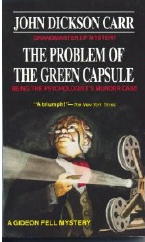
A series of poisonings of village children by means of doctored chocolates brings in a Scotland Yard detective, Andrew Elliot. While he’s there, it is learned that another murder has taken place: that of Marcus Chesney, a local millionaire whose niece, Marjorie, has been suspected of the earlier poisonings.
Chesney has died from poisoning! And he was being filmed at the time he was poisoned! Chesney was doing a demonstration of how the doctored chocolates had been substituted for the innocent chocolates in the village shop, testing the perceptions of an audience of three people: Marjorie; Marjorie’s fiance, George Harding; and a neighboring friend, Professor Ingram.
Chesney’s brother, Doctor Joe Chesney, had had to absent himself from the performance, while Marcus’ employee, Wilbur Emmet, was a participant in the performance, as the mysterious, muffled Mr. Nemo.
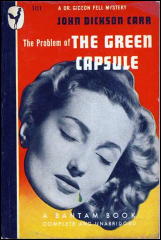
It is “Mr. Nemo” who forced a presumably poisoned capsule down Marcus Chesney’s throat. But Wilbur is found concussed in the yard after the performance. Was Wilbur really Mr. Nemo, or was someone else masquerading as him?
All three members of the audience seemingly have perfect alibis — they were watching the performance. Dr. Joe was attending a patient. So we have an impossible crime once again, though more in the nature of an alibi problem: how was someone able to get in position to poison Marcus?
I find this on re-reading still to be a very good detective novel, with an interesting problem, lucidly elucidated at the end. Some may find it short on action, but that’s okay with someone like me, who finds some Carr’s too active.
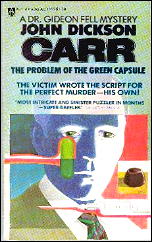
Interestingly, the Carr stand-in hero here is a young police inspector. On the whole, this works well. Dr. Fell does not appear until halfway through the book, and a very good police investigation is conducted until then. Then Inspector Elliott meets Dr. Fell, shouts that he loves Marjorie and confesses that he has concealed that he knew before taking the case that Marjorie tried to buy poison.
Fell (who it turns out is suppressing evidence about Marjorie as well) compliments Elliott on his chivalry. This put me off a bit. It seemed Carr’s romanticism getting the better of good sense. Any policeman behaving that way should have been drummed out of the force.
And that Elliot could have been “in love” with Marjorie to that extent after seeing her once in Pompeii (Pompeii is for lovers?) seemed absurd to me. But I think I’m the first person ever to complain about this, so I guess it isn’t an issue with most people.
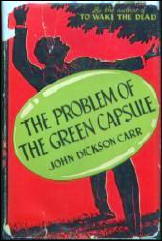
The characters are solid enough, classic Carr stock. We have the disputatious academic (Professor Ingram); the bluff, hearty fellow who roars a lot (Doctor Joe); the goody two shoes, obsequious male (George Harding — though did Carr really need to give us as black marks that he has “Southern European” looks and went to a “minor” public school, oh dear!); and the beautiful girl who is either an angel or a devil.
The police are nicely characterized (Major Crow only sounds like Carr once, when he informs Elliott of Marjorie: “For all her sweetly innocent looks, I hear she sometimes uses language that would startle a sergeant-major”).
There’s a lot of roaring from the male characters that goes on in this book (Dr. Fell even makes a roaring whisper, I don’t know how). I could do without the roaring myself, and I know this got on Barzun’s nerves.
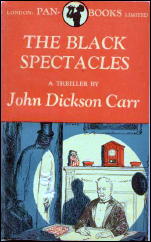
After reading Doug Greene’s excellent biography of Carr with all the information about his drinking, I can’t help wondering if the drinking bouts kind of influenced Carr’s writing in this regard. After all, drunken people do often roar and shout. Or maybe Carr was just naturally excitable.
We know he was strongly attracted to the more romantic past. It’s interesting that he was such good friends with the phlegmatic John Street. Of course, both Carr and Street had a fascination with and great talent for murder mechanics.
Carr often coupled this talent for murder with a Christie-level skill at misdirection, which makes him a truly major figure of the period even if one does like all his stylistic quirks. Barzun and Taylor are far too harshly critical of Carr (and it should be noted they never read many of his best books).
Nitpicking aside, this seems to me one of Carr’s strongest books. Not flashy, but a fascinating problem. One part of the explanation has a beautiful simplicity, but chances are the reader will miss it until it is revealed!
Editorial Comment: Curt has recently been re-reading a number of books by John Dickson Carr. This is the fourth in a series of reviews he wrote as a result. The Corpse in the Waxworks was the third, and you can read it here.
Wed 9 Jun 2010
Posted by Steve under
Reviews[11] Comments
A REVIEW BY CURT J. EVANS:
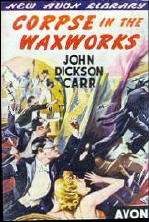
JOHN DICKSON CARR – The Corpse in the Waxworks. Harper & Brothers, US, hardcover, 1932. British edition published as The Waxworks Murder: Hamish Hamilton, hc, 1932. Reprinted many times in both hardcover and soft, including: Avon, paperback, no number [#33], 1943; Dell #775, pb,1954; Collier, pb, 1965 plus several reprintings.
The Corpse in the Waxworks is an early John Dickson Carr novel, one of the small set of highly Gothic tales set in France with “Satanic” series detective Henri Bencolin, whom Carr was to abandon after this tale (with the exception of one 1937 novel, The Four False Weapons, where Bencolin unfortunately is much toned down as a menacing, Mephistophelian character).
It’s an effective tale, and it offers a nice break in style from many of the Fell and Merrivale stories.
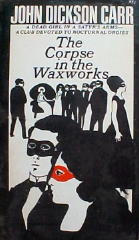
Waxworks quotes Edgar Allen Poe, and for good reason. The book is filled with gloom and grotesques and the writing is highly florid, with long descriptive paragraphs. Though not on the whole so much to my taste as his later, rather more stripped-down (though often still evocative) style, I think it is quite well done in Waxworks.
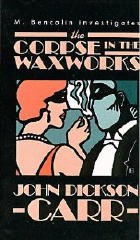
The mystery, involving a girl stabbed to death and left in the arms of a wax satyr in a museum’s Hall of Horrors, is a good one and fairly clued, although without all the long descriptive passages and a lengthy dramatic episode involving the dubious infiltration of a sinister sex club, the Club of Masks, by Jeff Marle, Bencolin’s young “Watson,” the book would actually be pretty short.
Overall, I’m reminded with Waxworks of Carr’s later historical mysteries from the 1950s and 1960s, though Waxworks is much more Gothic. Systematic criminal investigation seems to take something of a back seat to colorful, exciting episodes.
For me the very best part of Waxworks is the conclusion, highly dramatic confrontation between Bencolin and the murderer. I cannot say much, but I’ll just point out that Bencolin stays true to the rather the formidable, merciless self Carr fashioned for him in these early tales. You’ll remember this ending.
Editorial Comment: Curt has recently been re-reading a number of books by John Dickson Carr. This is the third in a series of reviews he wrote as a result. The Man Who Could Not Shudder was the second, and you can read it here.
Sun 6 Jun 2010
Posted by Steve under
Reviews[15] Comments
A REVIEW BY CURT J. EVANS:
JOHN DICKSON CARR – The Man Who Could Not Shudder. Harper & Brothers, US, hardcover, 1940. UK edition: Hamish Hamilton, 1940. Reprinted many times, in both hardcover and soft, including and shown here: Bantam #365, 1949; Zebra, 1986.
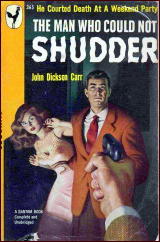
I wrote first-rate! in my paperback copy of this The Man Who Could Not Shudder back in 1993 — when as a young person I was first buying Carr, all those nice IPL, Harper and Zebra editions had come out, and Carr was very much alive and well in paperback, in contrast with today. On re-reading I really enjoyed this one, though this was one where I actually recalled most of the resolution as I read.
This is the one involving the miracle problem of guest at a country house party who is shot in the study of the house by a gun that seemingly moves of its volition. Did I mention the house is supposed to be haunted? There are strange stories of an ankle grabbing ghost of a former owner of the house who died in 1820 and, from a hundred years later,of a chandelier-swinging, octogenarian butler who died when the chandelier crash down on him.
Though is a haunted house tale, Carr does not lay on the Gothic shudders heavily this time. It’s a very modern haunted house, convincingly set in the late 1930s, with characters who act like real, normal people. (We do have one silly outburst of jealousy on the part of the narrator’s girlfriend, but that soon subsides.)
A couple of the characters, including the egoistic current owner of the house and one of the female guests, who is the highly desired wife of the murder victim, are very well done. (Concerning the latter there’s some discussion about sex that is pretty explicit for the period.)
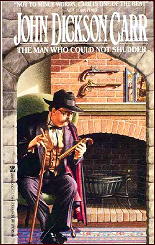
Dr. Fell is on hand, but I didn’t find his mannerisms irritating here. Inspector Elliot appears too — Shudder is a prequel to his later appearances in The Crooked Hinge and, what I believe was his last appearance, The Black Spectacles.
Shudder is one of Carr’s more John Rhodeian tales (I won’t say more, but Rhode readers who have read Shudder will know what I mean). It also takes place in John Street’s (the man who was John Rhode) personal territory: coastal, southern England.
Written shortly after the two friends collaborated on Fatal Descent/Drop to His Death, Shudder is, like The Reader Is Warned, a novel I could see being discussed over pints by the two men.
It’s also worth noting that the 1943 John Rhode novel, Men Die at Cyprus Lodge, involves a haunted house and some other bits similar to Shudder, though the plot turns out quite differently.
The murder method in Shudder is, as usual with Carr, cleverly clued; and there’s the bonus as well of a triple twist solution. The reader who makes it through all these hoops will be clever indeed. One action by Fell I thought outrageous, but for me it was explained sufficiently by the end, when we also learn that justice has been done.
Editorial Comment: Curt recently undertook the task of re-reading a number of books by John Dickson Carr. This is the second in a series of reviews he wrote as a result. He Who Whispers was the first to appear, and you can read it here.



























